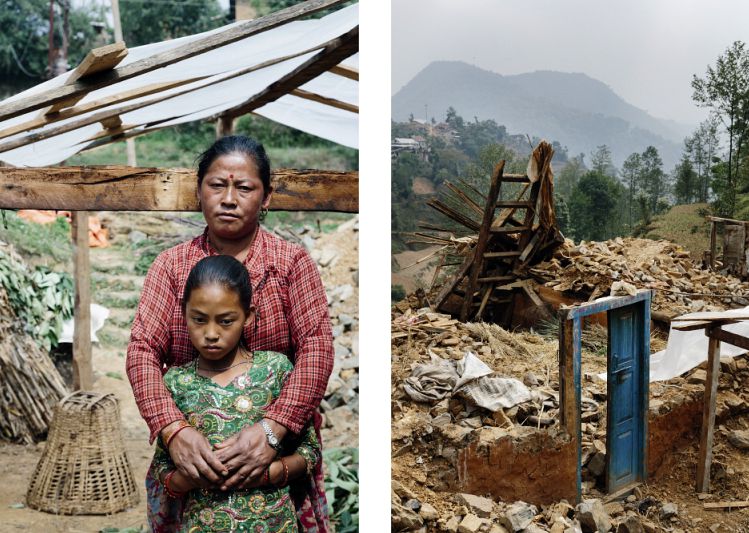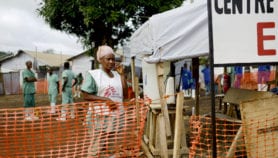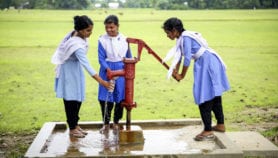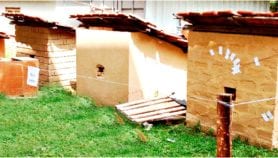Send to a friend
The details you provide on this page will not be used to send unsolicited email, and will not be sold to a 3rd party. See privacy policy.
Monica Wolfe Murray rounds up information sources and groups working on shelter in cities and after disaster.
The internet offers abundant information and insight into the complex challenge of securing shelter — whether urban or rural, or following displacement, economic migration or disasters — in resource-poor countries.
Growing shelter needs
Several alarming factors listed by the charity Habitat for Humanity are widening the gap between housing provision and requirements. Population growth is one, and the UN Department of Economic and Social Affairs highlights the latest figures and trends. It also presents data on accelerating urbanisation, which exacerbates poverty, conflicts and shelter needs.
World Bank data and SciDev.Net are among several information sources on climate change impacts, especially in resource-poor countries. The UN Office for Disaster Risk Reduction (UNISDR) provides data and statistics highlighting increasingly frequent and intense natural disasters. Insurance firm Munich Re provides further detailed statistics and also quantifies losses and economic impact. The UN information service ReliefWeb monitors natural disasters and provides updates on humanitarian action and assistance. A participatory platform for information exchange, Prevention Web, provides news and opinion on different disaster risk reduction (DRR) themes, including building safer homes and infrastructure after disasters.
The network ALNAP (Active Learning Network for Accountability and Performance), which facilitates learning and accountability in humanitarian work, reports an increased caseload of emergencies and discusses the need to adapt to this new reality. OCHA (UN Office for the Coordination of Humanitarian Affairs) provides further news, resources and insight into humanitarian caseloads and trends.
Shelter after disaster
The Centre for Development and Emergency Practice (CENDEP), at the United Kingdom’s Oxford Brookes University, provides information and training on shelter recovery after disasters. The centre’s publications collate and distil a wealth of insight and experience in humanitarian shelter. Papers from 2009, 2010 and 2011 highlight evolving thinking and strategy on shelter after disasters, in both urban and rural contexts. One paper, by shelter expert and academic Ian Davis, summarises lessons from 40 years of practice. An excellent literature review by architect and researcher Jeni Burnell evaluates the history and trends in 30 years of shelter provision. Resilient Urbanism, a collaborative blog, discusses the history, strategies and trends in post-disaster shelter recovery and urban shelter.
The second edition of the seminal Shelter after disasters, by the International Federation of Red Cross and Red Cresent Societies (IFRC), brings together enduring principles and practices developed 30 years ago as well as new approaches, progress and case studies. The book Transitional settlement, displaced populations provides an overview and guidelines for humanitarian workers on displaced people’s options for securing shelter.
The Global Shelter Cluster, convened by the IFRC and UNHCR (the UN refugee agency), coordinates shelter programmes and partners worldwide, offering wide-ranging resources. The NGO Shelter Centre provides further support for practitioners through an online library and training. Shelter Case Studies, affiliated with UN-Habitat, IFRC and UNHCR, publishes information about post-disaster programmes. UNISDR’s analytic Guidance note on recovery gives more case studies.
In addition to the crucial role of local NGOs — 4 out of 5 NGOs are national or local — these key organisations are involved in shelter provision worldwide:
-
These key organisations are involved in shelter provision worldwide:
-
International donors: DFID, World Bank, USAID
-
UN agencies: UNHCR, UN-Habitat, UNDP, UNISDR, UNOPS, OHCHR
-
Red Cross: IFRC, national Red Cross or Red Crescent Societies
-
International NGOs: Habitat for Humanity, Oxfam, Care, Practical Action, IRC, Acted, Shelter Box, World Vision, RedR
-
Intergovernmental or interagency bodies: IOM, ALNAP, Global Shelter Cluster
-
Think-tanks: CENDEP, ODI, IIED, ENHR, CRED
The UN Office of the High Commissioner for Human Rights (OHCHR) explains the right to housing in a factsheet, and provides further documentation including a toolkit and indicators for defining adequate housing. The Sphere Project, comprising 18 influential international organisations, publishes the Sphere handbook that details minimum standards for humanitarian response, including in the provision of shelter.
The Global Shelter Cluster provides guidance on the principles and requirements of rebuilding adequate shelters after disasters. A review of experiences and lessons reveals the sector’s ongoing preoccupation with defining what works and how to rebuild homes after disasters. Tokyo’s International Center for Urban Safety Engineering discusses the need to aim and plan towards the larger goal of reformative recovery: integrating shelter recovery with efforts to rebuild livelihoods as well as social and cultural interactions. Numerous publications, including academic and practice-based resources, suggest a shifting approach from simple house reconstruction to supporting communities so they can recover not only their homes, but also their livelihoods, social capital and overall resilience.
Disaster risk reduction
UNISDR provides information and insights into the interrelated concepts of hazard, risk and disaster and publishes the full text of the Sendai Framework for Disaster Risk Reduction.
Disaster risk reduction (DRR) has become a mainstream influence in planning humanitarian action. An assessment report by RedR includes a wealth of resources and examples of incorporating DRR into humanitarian work. A magazine by UK think-tank the Overseas Development Institute (ODI) publishes articles that highlight aid workers’ awareness of, and interest in, new shelter recovery approaches that reduce people’s vulnerability to disaster risks. An information sheet published by the consultancy Humanitarian Benchmark, 8 key messages for safer reconstruction in Philippines identifies simple, low-cost, easily adopted building elements that reduce vulnerability to specific hazards — showing that effective DRR measures don’t have to be highly technical or expensive.
An index produced by the Global Shelter Cluster reveals the type of technical guidance and resources that are now routinely available to shelter professionals. Other sources of information on shelter recovery after disasters include the UN service Relief Web, the UN News Centre and IRIN News. The ODI-affiliated Humanitarian Practice Network is a learning forum, and Reach is an information platform aiming to assist humanitarian decision-making.
Shelter in cities
UN-Habitat, the UN agency mandated with supporting a sustainable ‘urban future’, publishes urban data and reports that analyse the challenges of urban shelter through ‘wide-angle’ research and reporting.
Partnerships such as the Cities Alliance and policy research organisations such as the UK-based IIED provide further insight and propose solutions to housing issues in cities.
The magazine Forced migration review shares practical experience and research, including articles on the limitations of humanitarian approaches to securing shelter in cities. The Inter-Agency Standing Committee, a mechanism for coordination in humanitarian assistance, has proposed a strategy for making responses to urban crises more effective and reducing people’s vulnerability to such crises.
Innovation in shelter
Numerous free resources highlight innovations in shelter technology and design. Media portal Devex publishes information about innovative designs. The blog Inhabitat publishes on the future of design and sustainability in architecture, and tracks new shelter technologies, designs, practices and materials. It reports innovative shelter designs by architects and builders for after disasters or in high-density urban areas.
Examples of innovations range from a new ‘structural fabric’ for making emergency tents to flat-packed transitional shelters and even container skyscrapers. Some sources outline the merits or the shortcomings of a featured design — but few follow up to report whether it has been adopted by practitioners and communities.
Newspapers like The Guardian occasionally print stories on technological progress that could revolutionise humanitarian shelter. Another source of information on innovations is the World Habitat Awards. The NGO Practical Action also supports and publishes information on using technology to provide sustainable, affordable housing. And it provides a technical information service regarding various aspects of building.
Nonetheless, case studies and other materials produced by practitioners reveal a trend away from improving buildings through highly technological innovations. Instead, there is growing emphasis on helping communities to rebuild low-cost, locally sourced homes, often inspired by vernacular construction. Examples can be found in the Shelter Centre’s Humanitarian Library, research reports and the websites of NGOs such as the Nubian Vault Association, ACTED or the Heritage Foundation of Pakistan.
The Cities Alliance partnership makes the case for incremental housing in urban areas, while Arif Hasan, a fellow at IIED, proposes ways to support community-led urban expansion and development — the project’s blog and film provide more information on this proposal.
Sharing learning in shelter recovery
CENDEP’S events, conferences and publications are a rich source of insight and information on shelter and response to humanitarian crises. The World Bank has an Open Knowledge Repository with information on every aspect of relief and development assistance, including shelter. The Global Shelter Cluster and Shelter Centre constantly update and analyse data from projects that provide emergency, transitional or permanent shelter following disasters or conflict and displacement.
The Resilient Urbanism blog has published a post discussing the limiting factors in building an evidence base and introducing innovation. It outlines challenges in recording data from projects, draws lessons for future planning and practice, and highlights ethical and practical factors that stop innovations being adopted. A separate post also highlights why learning lessons is not a straightforward process in this sector.
High staff turnover in the humanitarian sector challenges continuity and institutional memory, but there are many training and learning resources for practitioners to draw from. These include the seminal report Shelter after disaster mentioned above, the Global Shelter Cluster’s document More than just a roof, a World Bank handbook on reconstruction, guidelines published by Oxfam, ALNAP’s guide for evaluating humanitarian action and a Q&A about humanitarian response published by the NGO RedR.
Monica Wolfe Murray is a writer and editor, and formerly programme design and implementation advisor at UN-Habitat. She can be contacted at [email protected]
This article is part of our Spotlight on Shelter crisis: Rebuilding after the storm.














